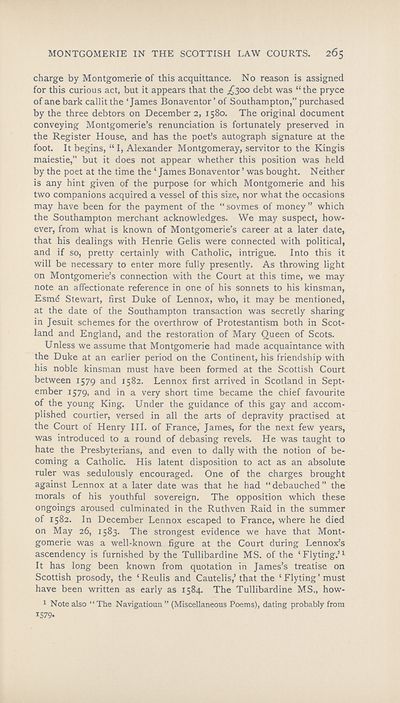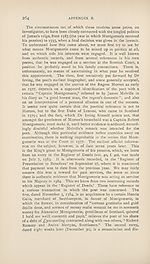Download files
Complete book:
Individual page:
Thumbnail gallery: Grid view | List view

MONTGOMERIE IN THE SCOTTISH LAW COURTS. 265
charge by Montgomerie of this acquittance. No reason is assigned
for this curious act, but it appears that the ^300 debt was “the pryce
of ane bark callit the ‘James Bonaventor ’ of Southampton,” purchased
by the three debtors on December 2, 1580. The original document
conveying Montgomerie’s renunciation is fortunately preserved in
the Register House, and has the poet’s autograph signature at the
foot. It begins, “ I, Alexander Montgomeray, servitor to the Kingis
maiestie,” but it does not appear whether this position was held
by the poet at the time the ‘ James Bonaventor ’ was bought. Neither
is any hint given of the purpose for which Montgomerie and his
two companions acquired a vessel of this size, nor what the occasions
may have been for the payment of the “ sovmes of money ” which
the Southampton merchant acknowledges. We may suspect, how¬
ever, from what is known of Montgomerie’s career at a later date,
that his dealings with Henrie Gelis were connected with political,
and if so, pretty certainly with Catholic, intrigue. Into this it
will be necessary to enter more fully presently. As throwing light
on Montgomerie’s connection with the Court at this time, we may
note an affectionate reference in one of his sonnets to his kinsman,
Esmd Stewart, first Duke of Lennox, who, it may be mentioned,
at the date of the Southampton transaction was secretly sharing
in Jesuit schemes for the overthrow of Protestantism both in Scot¬
land and England, and the restoration of Mary Queen of Scots.
Unless we assume that Montgomerie had made acquaintance with
the Duke at an earlier period on the Continent, his friendship with
his noble kinsman must have been formed at the Scottish Court
between 1579 and 1582. Lennox first arrived in Scotland in Sept¬
ember 1579, and in a very short time became the chief favourite
of the young King. Under the guidance of this gay and accom¬
plished courtier, versed in all the arts of depravity practised at
the Court of Henry III. of France, James, for the next few years,
was introduced to a round of debasing revels. He was taught to
hate the Presbyterians, and even to dally with the notion of be¬
coming a Catholic. His latent disposition to act as an absolute
ruler was sedulously encouraged. One of the charges brought
against Lennox at a later date w'as that he had “debauched” the
morals of his youthful sovereign. The opposition which these
ongoings aroused culminated in the Ruthven Raid in the summer
of 1582. In December Lennox escaped to France, where he died
on May 26, 1583. The strongest evidence we have that Mont¬
gomerie was a well-known figure at the Court during Lennox’s
ascendency is furnished by the Tullibardine MS. of the ‘Flyting.’1
It has long been known from quotation in James’s treatise on
Scottish prosody, the ‘Reulis and Cautelis,’that the ‘Flyting’must
have been written as early as 1584. The Tullibardine MS., how-
1 Note also “The Navigatioun” (Miscellaneous Poems), dating probably from
IS79.
charge by Montgomerie of this acquittance. No reason is assigned
for this curious act, but it appears that the ^300 debt was “the pryce
of ane bark callit the ‘James Bonaventor ’ of Southampton,” purchased
by the three debtors on December 2, 1580. The original document
conveying Montgomerie’s renunciation is fortunately preserved in
the Register House, and has the poet’s autograph signature at the
foot. It begins, “ I, Alexander Montgomeray, servitor to the Kingis
maiestie,” but it does not appear whether this position was held
by the poet at the time the ‘ James Bonaventor ’ was bought. Neither
is any hint given of the purpose for which Montgomerie and his
two companions acquired a vessel of this size, nor what the occasions
may have been for the payment of the “ sovmes of money ” which
the Southampton merchant acknowledges. We may suspect, how¬
ever, from what is known of Montgomerie’s career at a later date,
that his dealings with Henrie Gelis were connected with political,
and if so, pretty certainly with Catholic, intrigue. Into this it
will be necessary to enter more fully presently. As throwing light
on Montgomerie’s connection with the Court at this time, we may
note an affectionate reference in one of his sonnets to his kinsman,
Esmd Stewart, first Duke of Lennox, who, it may be mentioned,
at the date of the Southampton transaction was secretly sharing
in Jesuit schemes for the overthrow of Protestantism both in Scot¬
land and England, and the restoration of Mary Queen of Scots.
Unless we assume that Montgomerie had made acquaintance with
the Duke at an earlier period on the Continent, his friendship with
his noble kinsman must have been formed at the Scottish Court
between 1579 and 1582. Lennox first arrived in Scotland in Sept¬
ember 1579, and in a very short time became the chief favourite
of the young King. Under the guidance of this gay and accom¬
plished courtier, versed in all the arts of depravity practised at
the Court of Henry III. of France, James, for the next few years,
was introduced to a round of debasing revels. He was taught to
hate the Presbyterians, and even to dally with the notion of be¬
coming a Catholic. His latent disposition to act as an absolute
ruler was sedulously encouraged. One of the charges brought
against Lennox at a later date w'as that he had “debauched” the
morals of his youthful sovereign. The opposition which these
ongoings aroused culminated in the Ruthven Raid in the summer
of 1582. In December Lennox escaped to France, where he died
on May 26, 1583. The strongest evidence we have that Mont¬
gomerie was a well-known figure at the Court during Lennox’s
ascendency is furnished by the Tullibardine MS. of the ‘Flyting.’1
It has long been known from quotation in James’s treatise on
Scottish prosody, the ‘Reulis and Cautelis,’that the ‘Flyting’must
have been written as early as 1584. The Tullibardine MS., how-
1 Note also “The Navigatioun” (Miscellaneous Poems), dating probably from
IS79.
Set display mode to: Large image | Zoom image | Transcription
Images and transcriptions on this page, including medium image downloads, may be used under the Creative Commons Attribution 4.0 International Licence unless otherwise stated. ![]()
| Publications by Scottish clubs > Scottish Text Society publications > Old series > Poems of Alexander Montgomerie > (346) |
|---|
| Permanent URL | https://digital.nls.uk/110174201 |
|---|
| Description | A collection of over 100 Scottish texts dating from around 1400 to 1700. Most titles are in Scots, and include editions of poetry, drama, and prose by major Scottish writers such as John Barbour, William Dunbar, Gavin Douglas, and George Buchanan. Edited by a key scholarly publisher of Scotland's literary history, and published from the late 19th century onwards by the Scottish Text Society. Available here are STS series 1-3. |
|---|

